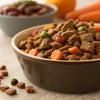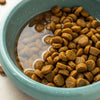How to Get a Dog to Eat Dry Food: Tips and Tricks for Picky Eaters
- Houndsy
Table of Contents
- Introduction
- Understanding Why Dogs Refuse Dry Food
- Tips to Encourage Your Dog to Eat Dry Food
- The Houndsy Approach to Dog Feeding
- Conclusion
Introduction
Have you ever watched your dog turn up their nose at a bowl full of dry food? You’re not alone—many dog owners experience this frustrating scenario. In fact, recent studies show that approximately 15% of dogs are considered picky eaters, which can be concerning when it comes to their health and nutrition. As devoted pet parents, we want our furry companions to enjoy their meals while receiving the essential nutrients they need to thrive.
In this blog post, we will explore various strategies to encourage your dog to eat dry food. From understanding the reasons behind their pickiness to actionable tips that can make their food more appealing, we aim to equip you with the knowledge and tools necessary to create a positive feeding experience. By the end of this article, you’ll have a comprehensive understanding of how to get a dog to eat dry food, along with insights that will help you improve your pet’s feeding routine.
We’ll cover important background information on dog eating habits, delve into common reasons for food refusal, and present effective techniques to address picky eating. We encourage you to reflect on your own feeding practices and consider how they align with your dog’s needs. Let’s dive in!
Understanding Why Dogs Refuse Dry Food
Before we can address the issue of picky eating, it’s crucial to understand why some dogs refuse to eat dry food in the first place. There are several potential reasons for this behavior, which can be categorized into health-related concerns and behavioral factors.
Health-Related Issues
- Dental Problems: Just like humans, dogs can experience dental pain from issues such as tooth decay, gum disease, or broken teeth. If your dog is experiencing discomfort while chewing, they may avoid dry food altogether. Regular dental check-ups and appropriate dental care can mitigate these problems.
- Digestive Disorders: Conditions like colitis, gastritis, or food intolerances can make eating dry food uncomfortable for your dog. Signs of digestive issues include vomiting, diarrhea, or bloating. If you suspect a medical issue, it’s essential to consult your veterinarian.
- Nausea: Dogs can experience nausea due to various reasons, including illness or anxiety. If your dog seems lethargic or shows other signs of discomfort, a veterinary visit is warranted.
- Age-Related Changes: Older dogs may develop health issues such as arthritis or reduced sense of smell, making it difficult for them to eat comfortably. They may also experience a decrease in appetite due to age-related factors.
Behavioral Factors
- Spoiled Eating Habits: If your dog has become accustomed to receiving table scraps or treats, they may develop a preference for more flavorful, human-like food. This can lead to a refusal to eat dry food if they find it less appealing.
- Environment and Routine Changes: Dogs thrive on routine and may become anxious or stressed in new environments or after changes to their feeding schedule. A quiet, familiar space for meals can help ease their anxiety.
- Boredom with Food: Just like us, dogs can get bored eating the same food day in and day out. Rotating their food flavors or introducing toppers can help maintain their interest in mealtime.
- Feeding Bowl Issues: Sometimes, a dog may avoid eating from a specific bowl due to its size, material, or cleanliness. Ensuring a comfortable and clean feeding area can make a significant difference.
Summary of Key Points
Understanding the reasons behind your dog’s refusal to eat dry food is critical for addressing the issue effectively. Whether it’s health-related or behavioral, identifying the root cause will help you tailor your approach to encourage your dog to eat.
Tips to Encourage Your Dog to Eat Dry Food
Having identified potential reasons for your dog’s pickiness, let’s explore some actionable strategies to encourage them to eat dry food. We believe that making mealtime enjoyable and stress-free is key to fostering healthy eating habits.
1. Evaluate and Adjust Their Diet
- Check the Food Quality: Ensure that you are providing high-quality dry food that meets your dog’s nutritional needs. Sometimes, switching to a premium brand can make a world of difference. At Houndsy, we recommend exploring our Houndsy Kibble Dispenser for fresh, high-quality kibble storage.
- Consider Food Rotation: Dogs can become bored with the same flavor. Consider rotating between different flavors or brands to reignite their interest in food.
2. Enhance the Food’s Appeal
- Add Toppers: Introducing healthy toppers can make dry food more enticing. Consider adding options like plain yogurt, pumpkin puree, or low-sodium chicken broth. These additions can enhance flavor and texture, making the meal more appealing.
- Warm the Food: Slightly warming the dry food can enhance its aroma, making it more appealing to your dog. Just ensure that it’s not too hot before serving it to them.
3. Create a Positive Feeding Environment
- Establish a Routine: Dogs thrive on routine. Set consistent feeding times and stick to them. This predictability can help reduce anxiety around mealtime.
- Choose the Right Location: Feed your dog in a quiet and familiar space, away from distractions. This can help them focus on their food and feel more at ease.
4. Encourage Healthy Eating Habits
- Limit Treats and Scraps: If your dog is used to receiving treats or table scraps, gradually reduce these offerings to encourage them to eat their dry food.
- Use the Gentle Starvation Method: If your dog refuses to eat after 30 minutes, remove their food until the next scheduled feeding. This method can encourage dogs to eat when they realize their food is not always available.
5. Address Potential Health Issues
- Regular Veterinary Check-ups: If your dog consistently refuses to eat, it’s important to consult your veterinarian. They can identify any underlying medical issues and recommend treatment.
- Dental Care: Ensure that your dog’s dental health is maintained through regular cleanings and appropriate chew toys. Healthy teeth and gums can significantly impact their willingness to eat dry food.
Summary of Key Points
By evaluating your dog’s diet, enhancing the appeal of their food, creating a positive feeding environment, encouraging healthy eating habits, and addressing potential health issues, you can help your dog develop a more consistent appetite for dry food.
The Houndsy Approach to Dog Feeding
At Houndsy, we understand the challenges of feeding our furry friends. That’s why we’ve dedicated ourselves to creating innovative products designed to elevate the feeding experience. Our Houndsy Kibble Dispenser exemplifies our commitment to convenience and style, making it easier for pet parents to provide their dogs with high-quality kibble.
With a standing height crank for easy access, perfect portion control, and a beautiful mid-century modern design, the Houndsy Kibble Dispenser not only simplifies feeding but also complements your home decor. Explore how our dispenser can transform your dog feeding routine by visiting our product page here.
Conclusion
Getting a dog to eat dry food doesn’t have to be an uphill battle. By understanding the reasons behind your dog’s pickiness and implementing the tips discussed in this article, you can create a more enjoyable and nutritious feeding experience. Remember to consider your dog’s health, preferences, and environment as you work towards encouraging them to eat their dry food.
Reflect on your current feeding habits—are there areas you can improve? Whether it’s introducing new flavors, enhancing the feeding environment, or investing in a stylish and functional feeder like the Houndsy Kibble Dispenser, small changes can lead to significant results.
In your journey to support your dog’s eating habits, we invite you to share your experiences and tips. Let’s empower each other as loving pet parents, committed to providing our furry companions with the best care possible.
FAQ
Q: My dog refuses to eat dry food but gobbles up treats. What should I do?
A: This is a common issue. Gradually reduce the number of treats given while enhancing their dry food with toppers or warm water to make it more enticing.
Q: How can I tell if my dog’s refusal to eat is health-related?
A: Look for signs such as vomiting, diarrhea, lethargy, or dental discomfort. If your dog has not eaten for more than 24 hours, it’s best to consult your veterinarian.
Q: Is it normal for my dog to be picky about their food?
A: Yes, many dogs can be picky eaters. Factors such as boredom, food quality, and routine changes can contribute to this behavior.
Q: How often should I feed my dog?
A: Most adult dogs do well with two meals a day. Puppies may require more frequent feeding. Establish a routine that works best for your dog.
Q: Can I use the Houndsy Kibble Dispenser for wet food?
A: The Houndsy Kibble Dispenser is specifically designed for dry kibble. For wet food, consider using separate containers that suit moist food storage.
By thoughtfully addressing your dog's needs and preferences, you can transform mealtime into a delightful experience for both you and your furry friend. Explore our Houndsy Kibble Dispenser here to elevate your dog feeding routine today!












